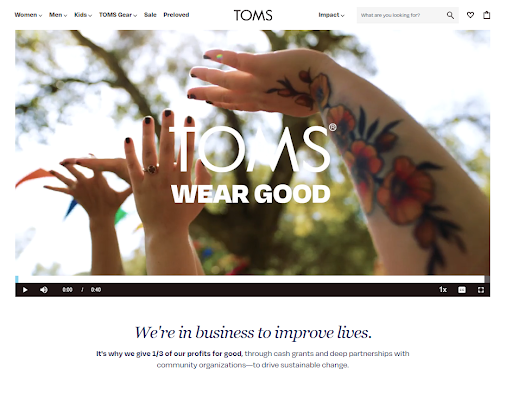
Climate change and pollution are often on my mind. I constantly see these topics in my social media feeds and on the news. This content has made me think more deeply about the environmental impact of my actions. I’ve already taken small steps to make a difference, like becoming a vegetarian.
This awareness has also made me more conscious about the brands I support. I want to give my money to companies that help the planet, not harm it. And I’m not the only customer who feels this way. Harris Poll research reports that 82% of shoppers want brands to share their values. Many of these customers will stop buying from companies they view as unethical.
Businesses can use cause marketing to demonstrate their values and make a difference. This technique lets companies and nonprofit organizations unite forces. The business makes a charitable donation to the charity and improves its reputation. In exchange, the nonprofit organization helps promote the partnership. It’s a win-win situation for everyone.
This guide examines the meaning, benefits, and challenges of cause marketing. We also explore tools for developing campaigns and building your contact list.
Introduction to cause marketing
Cause marketing is a partnership between a business and a nonprofit organization. This collaboration allows both parties to promote themselves and expand their reach. The company improves its image and proves its commitment to social responsibility. Meanwhile, the nonprofit gets exposure to new audiences.
This marketing technique has a long history in the United States. In 1983, American Express created the first formal cause marketing campaign. The company raised $1.7 million in three months to renovate the Statue of Liberty. This campaign also raised national awareness of the American Express credit card.
Cause marketing campaigns have proliferated in the last two decades. In 2004, businesses spent $990 million on cause sponsorship. In 2020, cause sponsorships surged to $10 billion due to the COVID-19 pandemic. This trend will likely continue as companies cater to customers who are passionate about social causes.
Cause-related marketing can significantly impact brand identity. These campaigns strengthen companies’ relationships with their communities and customers. They can also boost a brand’s reputation and attract new customers who care about the cause. Cause marketing is also an effective way to stand out from competitors.
How to develop a cause marketing strategy
You may feel tempted to partner with the first exciting nonprofit you find. But the most effective cause marketing campaigns take careful planning and consideration. Every aspect of your campaign must align with your values if you want to succeed.
Choose your cause
You can start by identifying a single cause that fits your brand identity and mission.
Consider these questions:
- What values and principles does your brand represent?
- What issues concern your customers?
- What causes do your employees feel passionate about?
- What causes are relevant to your industry or community?
- What type of content could you create to promote the cause?
Your campaign will feel more genuine if you pick a cause that gets you and your audience fired up. Promoting a cause with an obvious connection to your brand or products is also easier.
For example, suppose your company sells athletic equipment and wants to increase accessibility to sports. You could partner with a charity that helps people with disabilities play soccer. Or you could choose a nonprofit that supports young athletes from disadvantaged groups.
Align the cause with brand values
Your cause marketing campaign should go beyond surface-level engagement with a nonprofit. Consider how you can align your values and products with your chosen cause.
If your company partners with a nonprofit for athletes with disabilities, build on this campaign by making accessibility and inclusivity central to your mission. For example, you could include people with disabilities in your marketing materials. You can also design accessible sports equipment for athletes with disabilities. These efforts will create a culture of inclusivity far beyond your marketing campaign.
Determine your contribution
Many companies donate money to their partner organizations. But you don’t need to drain the company’s bank account to give support. Here are three ways you can give back:
- Organize events. Plan a fundraising event to raise money and connect your partner with new donors. For example, you can host a food festival or a 5K race.
- Create an email marketing campaign. Send your subscribers marketing emails about your cause. These messages can include educational content and information about the nonprofit. They should also have strong calls to action for donations or volunteers.
- Have an employee volunteer day. Clear your company’s schedule so your staff can volunteer for your cause. For instance, they could deliver food to a homeless shelter or run a charity event.
Get your audience involved
Inspire your audience to engage with your cause marketing campaign. You can encourage them to follow your nonprofit partner on social media and donate. You could also invite them to participate in charity events.
Implementing cause marketing campaigns
Once you’ve picked your cause, it’s time to implement your marketing campaign. These three strategies will help you achieve your goals and make an impact.
1. Use case studies for inspiration
Start by researching successful cause marketing examples. This step lets you learn about effective strategies and incorporate them into your own campaign.

For example, the shoe brand TOMS donates ⅓ of its profits to community organizations. The company partners with nonprofits that reflect its values of diversity, equity, and inclusion. TOMS markets this campaign through website pages, annual impact reports, and videos.

Two Blind Brothers is another helpful case study. As the name suggests, this clothing company was founded by two brothers with visual impairments. The business donates 100% of its profits to charities and researchers supporting the blind community. Two Blind Brothers promotes their cause through an animated film, blog posts, and social media.
These case studies show the importance of choosing a cause aligned with your company’s values. They also highlight some of the strategies marketers use to advertise their causes.
2. Co-promote your campaign with your partner
Your nonprofit partner is your greatest ally for your campaign. Together, you can develop strategies to co-market the cause to your audiences.
These techniques could include:
- Creating Instagram Collab posts
- Collaborating on content like e-books and webinars
- Developing a shared landing page for the campaign
- Partnering with influencers
- Co-launching a year-end fundraising campaign
3. Measure your performance
Track your campaign’s performance to see how audiences respond to your content. Your goals can help you determine which metrics to use.
If you want to raise awareness of your nonprofit partner, measure donations and social media engagement. If you want to boost your brand’s reputation, track brand sentiment and customer satisfaction.
Other valuable metrics include:
- Click-through rates
- Return on investment
- Sales
- Share of voice
- Social media impressions
- Website traffic
Benefits of cause marketing
Cause marketing has many advantages for businesses of all sizes. Many consumers expect brands to address environmental and social issues. Supporting a cause helps you meet this demand and builds customer loyalty.
This strategy can also improve your brand’s public perception. Your audience will view your company as ethical and socially responsible. This view may persuade them to choose you over competitors. Media outlets may also spotlight your campaign, leading to more positive exposure.
There are also many cause marketing benefits for your nonprofit partner. Nonprofits often have limited financial and human resources. Your company can provide valuable marketing support to help them reach new audiences. Your campaign may also inspire consumers to donate to your partner.
Common challenges of cause marketing
Cause-related marketing has many benefits but can come with unique challenges.
Some brands struggle to find the right cause. Overcome this obstacle by defining your values and mission. Look for nonprofit organizations that align with these principles. You can also research your audience’s interests to identify relevant causes.
A poorly planned campaign can also put your brand reputation at risk. Some businesses choose controversial causes that offend their target audience. Companies may also face backlash if they use insensitive messaging.
For example, Pepsi drew controversy in 2017 after it released a commercial featuring the white model Kendall Jenner. The ad shows Jenner defusing a protest by handing a police officer a can of Pepsi. Time called the commercial “a glaring misstep” that trivializes real protests like the Black Lives Matter movement. Pepsi quickly withdrew the ad and issued an apology.
Avoid this risk by choosing partners and causes that have positive public perceptions. Hiring a sensitivity reader can also help create tactful and respectful messaging.
Advanced cause marketing tactics
Expand your campaign’s reach with digital marketing. This approach involves sharing your message through digital channels. Many brands use social media and blog posts to promote their causes. Email marketing also lets you share messages about your campaign with subscribers.
Content marketing can also help you engage audiences. This strategy lets you tell persuasive stories about your cause and nonprofit partner.
For example, you could create videos and infographics about your partner’s impact. You can also share campaign updates on your blog and website.
Integrating cause marketing with other business areas
Combine cause marketing with other business areas to amplify your impact.
Your sales department can create promotions related to your cause. Customers could get exclusive discounts if they donate to your partner.
You could also develop co-branded products. For example, BrewDog created a limited-edition beer called “Street Dog.” Each can features an adoptable dog. The brewery donated the sale proceeds from this beer to animal charities.

Cause marketing businesses should also integrate this strategy into their website operations. Create a landing page that shares information about your collaboration. You should also include calls to action to encourage visitors to donate or learn more.
Legal and ethical considerations in cause marketing
Cause marketing raises more ethical and legal dilemmas than other practices. Marketers must focus on accountability and transparency to maintain customer trust. Always explain how your partner uses donations and ensure they follow through on their commitments.
Businesses must also follow relevant regulations for cause marketing. These requirements vary by state but may include:
- Commercial coventurers for charitable purposes. Several states require cause marketing companies to register as commercial coventurers. These laws may apply if your company gives a percentage of its sales to charity.
- Marketing transparency laws. The federal government requires businesses to create truthful and evidence-based advertisements. It also forbids deceptive and unfair marketing.
Finally, businesses should avoid “causewashing.” Companies that engage in this unethical practice support causes to make money, not to make a genuine difference. Causewashing often occurs when businesses try to take advantage of a popular cause.
Create authentic campaigns by focusing on causes that fit your mission. You should also commit to your cause for an extended period instead of jumping on the latest fad.
Tools and software to support cause marketing
There are many resources to help cause marketing agencies create effective campaigns.
Customer relationship management (CRM) software is an essential tool. Constant Contact’s CRM helps you promote your campaign to your ideal audience.
You can build custom landing pages and email campaigns to reach potential supporters. The platform’s simple contact management features also make it easy to create a shared mailing list for you and your partners.
Constant Contact’s marketing automation tool also streamlines messaging. The platform automatically sends emails, social media posts, and other content. This feature saves time and helps you reach supporters at the right time. You can also watch your campaign performance with built-in data analytics tools.
Make an impact with cause marketing
Raise awareness about environmental and social issues with cause-related marketing. This strategy lets you support important causes while improving your brand reputation. It’s one of the best ways to build trust with young customers and other audiences. Plus, you’ll get to help exciting nonprofits make a bigger impact.
Start your cause marketing journey by clarifying your values. Next, look for a nonprofit that resonates with your mission. Get in touch to see if they’re interested in collaborating and start building a relationship.
With a little effort, you can work together to drive social change.




